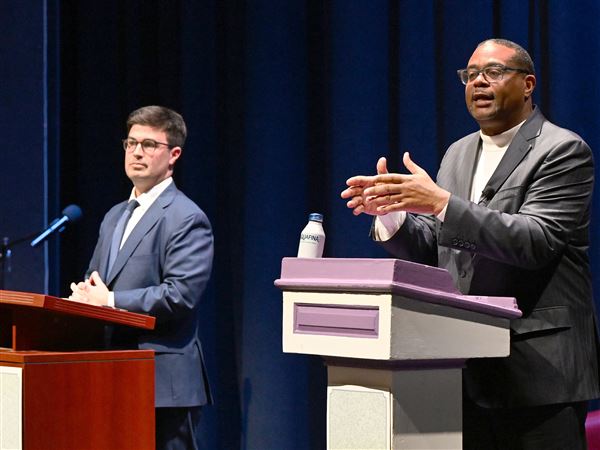
"Tutankhamun and the Golden Age of the Pharaohs" will be on display at The Field Museum in Chicago through January, 2007.
Click photo for larger image
Pittsburgh Post-Gazette

Audio slideshow: A new look at the Boy King. David Foster, project manager for exhibitions at the Field Museum in Chicago, provides an insiders view of "Tutankhamun and the Golden Age of the Pharaohs."
Click photo for larger image.
Related coverage
 Before and after Tut, indulge in Chicago's other treasures
Before and after Tut, indulge in Chicago's other treasures
CHICAGO -- People have had a fascination for all things Egyptian ever since the early 18th century, when European archaeologists began exploring the Valley of the Kings in Upper Egypt. But it wasn't until English archaeologist Howard Carter discovered the remarkably preserved tomb of the boy king Tutankhamun in 1922 that much of the world became obsessed.
That spectacular find, which included thousands of items and took close to 10 years to catalog, remove and conserve, soon influenced everything from hair and clothing styles to Hollywood movies.
It also made an icon of the young Tut. Only 9 or 10 when he became king of the most powerful nation in the Mediterranean world in 1332 B.C., he died under sudden and mysterious circumstances just 10 years later.
I'm among King Tut's disciples. In 1981, as a college student traveling abroad, I stood in line for more than six hours in Hamburg, Germany, to catch a traveling exhibit of artifacts from that historic find.
So I was among the first to preregister for tickets when I learned a new and much larger exhibit was heading to four U.S. cities, including two within driving distance of Pittsburgh -- Chicago and Philadelphia. I wanted to make sure I wouldn't miss out: Some 8 million people lined up to see the "Treasures of Tutankhamun" exhibition that traveled between 1976 and 1979 to six U.S. museums.
My family and I over Memorial Day weekend caught the show at Chicago's Field Museum, where it opened May 26 and runs through Jan. 1. (It doesn't open in Philly until Feb. 1, 2007.) Rumor has it that the artifacts will likely never travel again as proceeds from the American tour will be used to help build the Great Egyptian Museum near the pyramids at Giza.

A detail of the life-size mannequin of King Tut from the exhibit at the Field Museum, Chicago. The focus of this inlaid pectoral, above, is the scarab beetle, representing Khepri, the newborn. With the elements of the composition, the sun disk (Re), the three strokes and the basket, it cryptographically spells out Tutankhamun's throne name, Nebkheperure.
Click photo for larger image.
It's possible to get tickets at the door, of course. But there's no guarantee you'll get the day or time you desire, considering that more than 225,000 advance tickets have already been sold. Yet even if you have to stand in line at the ticket counter or, as I did, spend serious time on the computer trying to lock in the right date, it's worth it. The show is spectacular.
In all, "Tutankhamun and the Golden Age of the Pharaohs" features more than 130 treasures from Tut's and other royal tombs, including some that have never before left Egypt. Among these are the beautiful gold diadem found on the head of the mummy. Most artifacts are in pristine condition and, to the tourgoer's delight, within a couple of feet away in glass cases.
One big showstopper is a 6-foot wooden boat model that was found in the tomb of one of the 18th dynasty's earlier pharaohs. A reference to routine transportation on the Nile during the king's temporal life, it served a magical function in the tomb -- to ferry him into the afterlife. Even more magnificent is the solid gold coffin and mummy mask of Tjuya, thought to be Tutankhamun's great-grandmother. Dead center in a darkened room filled with funerary objects related to Tut's family, it gleams out of the blackness as if being stabbed by shafts of sunlight.
Other objects worth noting include a small portrait bust of Queen Nefertiti, two gold statuettes of Tut as the king of Upper and Lower Egypt, and a small gold shrine covered by scenes in relief depicting Tut and his wife, Ankhsenamun, in various activities.

This is the front view of the 15 1/2-inch Viscera Coffin. This was specifically designed to hold King Tut's mummified liver, which was believed to be essential in the afterlife.
Click photo for larger image.
As for Tutankhamun himself? Fifty of the objects come directly from the young pharaoh's tomb, which was raided shortly after he was buried and then hastily resealed. They include a small wood and ebony chair with lion paw legs he likely used as his royal seat, a falcon collar of sheet gold that was wrapped around the neck of his mummy, and a golden ceremonial dagger and sheath that was meant to protect him in the afterlife.
An important disclosure: You don't get to view the lustrous gold death mask that was placed over the head and shoulders of his mummy. Nor will you catch a glimpse of any of the three nested golden coffins, separated by sheets of linen when Mr. Carter opened them in 1925, that held his preserved corpse. The mask and the two inner coffins are displayed in the Egyptian Museum in Cairo, while the outermost one still resides in his tomb, along with his mummy, in the Valley of the Kings.
Not only are they too fragile and priceless in value to travel, said David Foster, project manager director for exhibitions at the Field Museum, but they're too closely identified with Egyptian antiquity to leave the country. The funerary mask, in particular, is what many people go to see in Cairo.
"It's like the Mona Lisa in the Louvre," he said.
You will, however, come face to face with the 15-inch coffinette that held Tutankhamun's mummified liver, as well an exquisite calcite canopic stopper in the shape of the king's head (used to hold viscera). There's also a funerary mask for a fetus that may have been the stillborn child of Tut and his queen, and a gold-and-carnelian collar found folded on his thighs.
The two previous tours in the United States in the early '60s and late '70s, were presented more as art shows of beautiful objects. This one is marked by more context, story and chronology. The 70 or so artifacts that preface Tut's objects illustrate the daily life of ancient Egyptians and shed light on his family's dynasty, Mr. Foster said.

Tutankhamun's heart scarab lies in the center of this stone and glass pectoral, a type of large necklace worn on the chest.
Click photo for larger image.
Curiously, Tut was the least important king in the entire 18th dynasty, which stretched more than 250 years before his birth and included some of the kings and queens who forged the Egyptian empire. It's the sheer accidental survival of his amazing tomb, Mr. Foster noted, that invested him with a fame that outweighs his historical significance.
"There is a certain pathos and poignancy to his human story that has captured people's imaginations," he said.
The exhibition also teaches visitors about the mummification process and the steps Egyptians took to protect the body for the afterlife.
Then there's the science of Tut. The last of the exhibition's 11 galleries is devoted to the CT scans of the mummy, sponsored by the National Geographic Society in 2005, that revealed a massive fracture above Tut's left knee that he seems to have experienced days before his death. An X-ray in 1968 put forth the theory that the king had been killed by a blow to the head in a moment of palace intrigue; a 3-D reconstructed image of that CT scan, Mr. Foster said, appears to disprove that.
"The theory now is that that fracture became massively infected and that he might have died very quickly, and naturally, from blood poisoning," he said.

The Field Museum's gift store is prepared for expected large crowds of visitors for "Tutankhamun and the Golden Age of the Pharaohs."
Click photo for larger image.
Close to 1 million visitors are expected to see the exhibit while it's in Chicago for its seven-month run, Mr. Foster said.
Just plan on giving it some time. It took nearly 40 minutes after entering the museum at the appointed time to get to the exhibition door. Once in, the line at times moved slowly.
The labels and wall texts are easy to read, and for an even richer experience, I highly recommend spending an extra $6 on an audio tour, narrated by actor Omar Sharif. (It also wouldn't hurt to do a little reading beforehand to understand the back story on the Valley of the Kings.)
Take cash for souvenirs. Along with T-shirts and posters, the museum shop sells Tut chocolates, jewelry, miniature busts, hieroglyphics ties and tiny mummies.
I settled for a $4 refrigerator magnet. The tour itself, I figured, was memory enough.



King Tut exhibit
For more information on "Tutankhamun and the Golden Age of the Pharaohs" or to purchase tickets, visit www.fieldmuseum.org/tut or call 1-312-922-9410. Tickets during regular museum hours cost $25 for adults, $22 for seniors and students and $16 for children ages 4-11. For more information, see "Planning Your Visit" on the museum's Web site.
First Published: June 11, 2006, 4:00 a.m.















